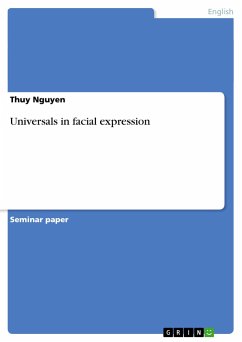Seminar paper from the year 2005 in the subject English Language and Literature Studies - Linguistics, grade: 1,7, University of Duisburg-Essen, course: Non-verbal aspects of communication , language: English, abstract: This essay deals with the question whether facial expressions are universal meaningthat all cultures use the same mimics for expressing a certain feeling. Are theseexpressions innate or do they have to be learned?First, I will give an overview of Charles Darwin's theory about the universality of facialexpressions because he was the first who dealt in detail with this issue.The chapter is subdivided in three parts: the first part describes the relationshipbetween the facial expressions of nonhuman primates and human primates. Thefollowing part deals with Darwin's observations of the facial expression in infants andchildren including those children that have no opportunity to learn facial expressionsfrom others. Finally, Darwin's method of cross-cultural study in order to provideevidence for his claim will be presented.The second chapter depicts the behaviourists' position that in contrast to theUniversalists' point of view is based on the belief that all facial expressions arelearned and culturally bound.The main chapter represents the most current and detailed research of facialexpressions. The studies of Paul Ekman and Wallace Friesen refer mainly to Darwinbut also consider the cultural aspect. They introduce a neurocultural theory ofemotions, showing that the facial behaviour itself is determined by biological factorsas well as by social factors. Further, I will give a summary of three importantexperiments Ekman and Friesen conducted in order to proof that the facialexpressions for the six basic emotions are universal.[...]
Hinweis: Dieser Artikel kann nur an eine deutsche Lieferadresse ausgeliefert werden.
Hinweis: Dieser Artikel kann nur an eine deutsche Lieferadresse ausgeliefert werden.








